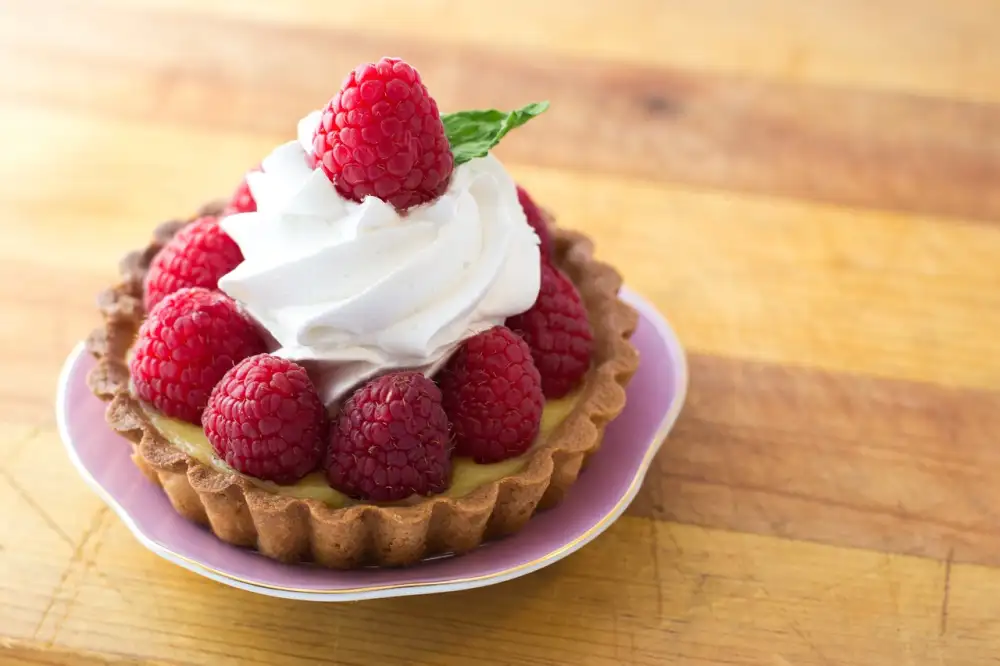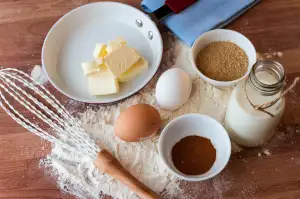Whisking Wonders: A Step-by-Step Guide on How to Make Custard

Custard, a classic dessert loved by many, is a creamy and indulgent treat that has been enjoyed for centuries. With its smooth texture and rich flavor, custard is the perfect ending to any meal. Whether served on its own or used as a filling in pies and tarts, custard never fails to delight taste buds with its velvety goodness.
This delectable dessert has a long history, dating back to ancient Rome and Greece. The word "custard" originates from the French word "croustade," meaning crust. Traditionally made with milk or cream, eggs, sugar, and flavorings such as vanilla or nutmeg, custard is a versatile dessert that can be customized to suit individual preferences.
Custard comes in various forms, including baked custard, stirred custard, and pastry cream. Baked custards are cooked in the oven until set and may have a caramelized top layer. Stirred custards are cooked on the stovetop and require constant whisking to achieve a smooth consistency. Pastry cream is a thickened version of custard commonly used as a filling in pastries like éclairs and cream puffs.
In addition to its delicious taste and versatility, custard also offers nutritional benefits. It is an excellent source of protein from eggs and provides essential vitamins and minerals like calcium from milk. However, it's important to enjoy custard in moderation due to its high calorie content.
Whether you're a seasoned chef or just starting your culinary journey, mastering the art of making custard will elevate your dessert game. In this step-by-step guide, we'll walk you through the process of creating silky-smooth homemade custard that will leave you craving for more. So grab your whisk and let's get started on this delightful culinary adventure!
Ingredients for Custard
To make a delicious custard, you will need the following ingredients:
- Milk: Use whole milk for a rich and creamy texture. You can also use half-and-half or a combination of milk and cream for an even richer custard.
- Sugar: Granulated sugar is commonly used to sweeten the custard. The amount of sugar can be adjusted according to your taste preferences.
- Egg yolks: The egg yolks provide richness and help thicken the custard. Make sure to use fresh eggs for the best results.
- Vanilla extract: This is an optional ingredient that adds a delightful flavor to the custard. You can use pure vanilla extract or vanilla bean paste for a more intense flavor.
- Cornstarch (optional): If you prefer a thicker custard, you can add cornstarch during the cooking process. This helps give the custard a smooth and velvety consistency.
These basic ingredients form the foundation of a classic custard recipe. However, feel free to experiment with additional flavors such as cinnamon, nutmeg, or even fruit extracts to create your own unique variations of custard.
Step-by-Step Instructions for Making Custard
1. Heat the milk: In a saucepan, heat the milk over medium heat until it reaches a gentle simmer. Avoid boiling the milk as it may scorch or curdle.
2. Mix the sugar and egg yolks: In a separate bowl, whisk together the sugar and egg yolks until well combined. The sugar will help sweeten the custard while the egg yolks provide richness and thickness.
3. Temper the egg mixture: Slowly pour a small amount of hot milk into the egg mixture while continuously whisking. This process, known as tempering, prevents the eggs from curdling when mixed with hot liquid.
4. Combine the milk and egg mixture: Gradually pour the tempered egg mixture back into the saucepan with the remaining hot milk, stirring constantly to ensure even distribution.
5. Cook the custard: Place the saucepan back on low heat and cook the custard mixture, stirring constantly with a wooden spoon or spatula. Continue cooking until the custard thickens enough to coat the back of a spoon.
6. Add flavorings (optional): If desired, add vanilla extract, nutmeg, or other flavorings to enhance the taste of your custard. Stir well to incorporate these flavors evenly throughout.
7. Chill the custard: Once cooked, remove from heat and let it cool slightly before transferring it to a container or individual serving dishes. Cover with plastic wrap directly touching its surface to prevent a skin from forming and refrigerate until fully chilled.
By following these step-by-step instructions, you can create a smooth and creamy custard that will surely delight your taste buds!
Heat the milk
Heat the milk is the first step in making custard. Start by pouring the desired amount of milk into a saucepan and placing it over medium heat. It is important to heat the milk slowly and gently to prevent scorching or curdling. Stir the milk occasionally to ensure even heating. Heat the milk until it reaches a scalding temperature, just below boiling point. This can be determined by small bubbles forming around the edges of the saucepan and steam rising from the surface of the milk. Once heated, remove the saucepan from the heat and set it aside while you prepare the other ingredients for your custard recipe.
Mix the sugar and egg yolks
To create a smooth and creamy custard, it is crucial to mix the sugar and egg yolks correctly. In a medium-sized bowl, whisk together the desired amount of sugar with the egg yolks until they are well combined. This step helps to dissolve the sugar and incorporate it evenly into the mixture. The sugar not only adds sweetness but also helps to stabilize the custard and give it a smooth texture. Make sure to whisk vigorously for about 2-3 minutes until the mixture becomes pale yellow in color and slightly thickened. Mixing the sugar and egg yolks thoroughly ensures that your custard will have a consistent taste and texture throughout.
Temper the egg mixture
3.3 Temper the egg mixture
Tempering is a crucial step in making custard to prevent the eggs from curdling when they come into contact with hot liquid. To temper the egg mixture, slowly pour a small amount of the hot milk into the sugar and egg yolks while continuously whisking. This gradual addition of hot liquid raises the temperature of the eggs gradually, ensuring a smooth and creamy custard texture.
The key here is to whisk vigorously as you pour the hot milk to evenly distribute the heat and prevent any lumps from forming. Be patient and take your time with this step, as rushing can result in a lumpy or curdled custard.
Once you have incorporated a small amount of hot milk into the egg mixture, continue adding more hot milk in a slow and steady stream while whisking constantly. This process gradually brings up the temperature of the eggs without shocking them, creating a stable emulsion that will result in a silky-smooth custard.
By tempering the egg mixture properly, you ensure that your custard will have a velvety texture and avoid any unwanted scrambled eggs. So remember, patience and constant whisking are key when it comes to tempering your egg mixture for perfect custard every time.
Combine the milk and egg mixture
Combine the milk and egg mixture: Once the milk is heated, slowly pour it into the sugar and egg yolk mixture while continuously whisking. This process is called tempering, which prevents the eggs from curdling when they come into contact with hot liquid. Gradually add the hot milk in a steady stream, whisking constantly to ensure a smooth and creamy custard base. Be careful not to pour too quickly or stop whisking, as this can result in lumps forming in the custard. Continue whisking until all the ingredients are well combined and you have a homogeneous mixture.
Cook the custard
Once the milk and egg mixture is combined, it's time to cook the custard. Pour the mixture into a saucepan and place it over medium heat. Stir continuously with a wooden spoon or whisk to prevent lumps from forming.
Continue cooking the custard until it thickens enough to coat the back of your spoon. This process usually takes around 10-15 minutes, but be sure to keep an eye on it as it can thicken quickly towards the end.
Avoid boiling the custard, as this can cause it to curdle. If you notice any small lumps forming, simply remove the saucepan from heat and whisk vigorously until they dissolve.
Remember to be patient during this step, as slow and steady heating ensures a smooth and creamy texture for your custard.
Once cooked, remove the saucepan from heat and let the custard cool slightly before adding any flavorings or transferring it to a container for chilling.
Cooking custard requires attention and precision, but with practice, you'll master this crucial step in creating a delectable dessert.
Add flavorings (optional)
Once you have cooked the custard base, you can enhance its taste by adding various flavorings. Here are a few popular options:
1. Vanilla: Add a teaspoon of pure vanilla extract or scrape the seeds from a vanilla bean and stir them into the custard. This classic flavor will give your custard a warm and comforting aroma.
2. Chocolate: Melt some high-quality chocolate and whisk it into the hot custard until it is fully incorporated. You can use either dark, milk, or white chocolate depending on your preference.
3. Citrus zest: Grate the zest of an orange, lemon, or lime and mix it into the custard for a refreshing citrus twist. Be careful not to include any bitter white pith while grating.
4. Nutmeg: Grate fresh nutmeg directly into the custard for a warm and slightly spicy flavor. A little goes a long way, so start with just a pinch and adjust according to your taste.
5. Almond extract: Add a few drops of almond extract to give your custard a subtle nutty flavor that pairs well with fruits like berries or peaches.
Remember to add these flavorings after cooking the custard base and before chilling it. Stir well to ensure they are evenly distributed throughout the mixture. Experiment with different combinations to create unique flavors that suit your palate.
Chill the custard
Chilling the custard is an essential step in the custard-making process. It not only helps to set the custard but also enhances its flavor and texture. Here's how to properly chill your custard:
- Remove the cooked custard from heat and let it cool slightly for about 10 minutes.
- Place a piece of plastic wrap directly on the surface of the custard to prevent a skin from forming.
- Transfer the custard to a shallow container or individual serving dishes, depending on your preference.
- Place the container(s) in the refrigerator and allow them to chill for at least 2-3 hours, or preferably overnight.
- During this time, the custard will firm up and develop a smooth, creamy consistency.
Chilling the custard allows it to fully set and develop its flavors. It also gives you an opportunity to prepare it in advance, making it a convenient dessert option for gatherings or special occasions.
Remember, when serving chilled custard, remove it from the refrigerator a few minutes before serving to allow it to soften slightly. This will make it easier to scoop or serve.
By following these steps, you can ensure that your homemade custards are perfectly chilled and ready to be enjoyed by all!
Tips for Perfect Custard
1. Use a heavy-bottomed saucepan: A heavy-bottomed saucepan helps distribute heat evenly and prevents the custard from scorching or curdling.
2. Heat the milk gently: Gradually heating the milk on low heat prevents it from boiling and forming a skin, resulting in a smoother custard.
3. Temper the egg mixture slowly: Adding hot milk to the egg mixture gradually while whisking constantly helps prevent the eggs from curdling and ensures a smooth texture.
4. Strain the custard: To remove any lumps or cooked bits of egg, strain the custard through a fine-mesh sieve before chilling it.
5. Avoid overcooking: Cook the custard until it thickens and coats the back of a spoon, but be careful not to overcook it as this can result in a grainy texture.
6. Stir constantly: While cooking the custard, stir constantly to prevent it from sticking to the bottom of the pan and forming lumps.
7. Cool properly before chilling: Allow the custard to cool at room temperature for about 10 minutes before placing it in the refrigerator to chill. This helps prevent condensation from forming on top of the custard.
8. Cover with plastic wrap: To prevent a skin from forming on top of the chilled custard, cover it with plastic wrap directly touching its surface before refrigerating.
9. Serve at room temperature: For optimal flavor and texture, allow chilled custard to come to room temperature before serving.
By following these tips, you can create a perfectly creamy and delicious custard every time!
Serving Suggestions for Custard
Custard is a versatile dessert that can be enjoyed in various ways. Here are some serving suggestions to enhance your custard experience:
1. Classic Custard: Serve the custard chilled in individual ramekins or bowls, topped with a sprinkle of nutmeg or cinnamon for a traditional touch.
2. Fruit Parfait: Layer the chilled custard with fresh fruits like berries, sliced peaches, or mangoes in a glass or parfait dish. Top it off with whipped cream and a drizzle of caramel sauce.
3. Trifle Delight: Create layers of cubed cake, custard, and your favorite fruits in a trifle dish. Repeat the layers and finish with whipped cream and a garnish of toasted almonds or chocolate shavings.
4. Crème Brûlée: Transform your custard into an elegant dessert by sprinkling a thin layer of sugar on top and caramelizing it using a kitchen torch until it forms a crispy crust.
5. Tarts and Pies: Use the custard as a filling for tarts or pies. Simply pour the custard into pre-baked tart shells or pie crusts and bake until set. Top with fresh fruits or whipped cream before serving.
6. Sauce Accompaniment: Warm up the custard slightly and serve it as a luscious sauce alongside warm desserts like bread pudding, apple pie, or chocolate cake.
Remember to get creative with your presentation by adding garnishes such as mint leaves, grated chocolate, or fruit coulis to make your custard visually appealing. Enjoy this creamy delight on its own or paired with other desserts for an indulgent treat!
In conclusion, making custard is a delightful culinary adventure that can be easily mastered with the right ingredients and techniques. By following these step-by-step instructions, you can create a smooth and creamy custard that will impress your family and friends. Remember to heat the milk, mix the sugar and egg yolks, temper the egg mixture, combine the milk and eggs, cook the custard, add flavorings if desired, and chill it before serving. With a little practice and attention to detail, you'll be able to whisk up wonders in no time. So go ahead and indulge in the rich flavors of homemade custard – it's a treat worth savoring!
Published: 26. 02. 2024
Category: Recipes



